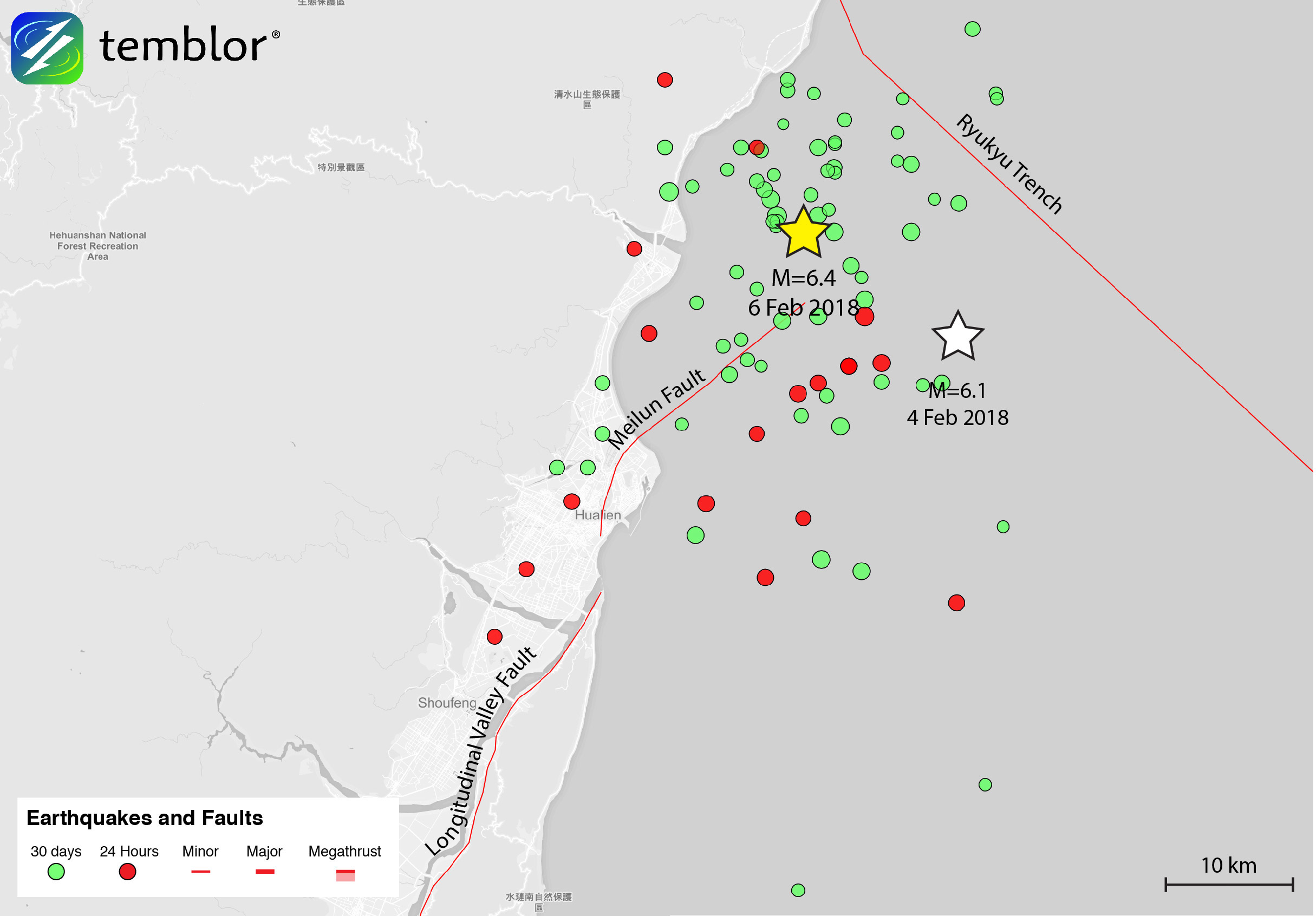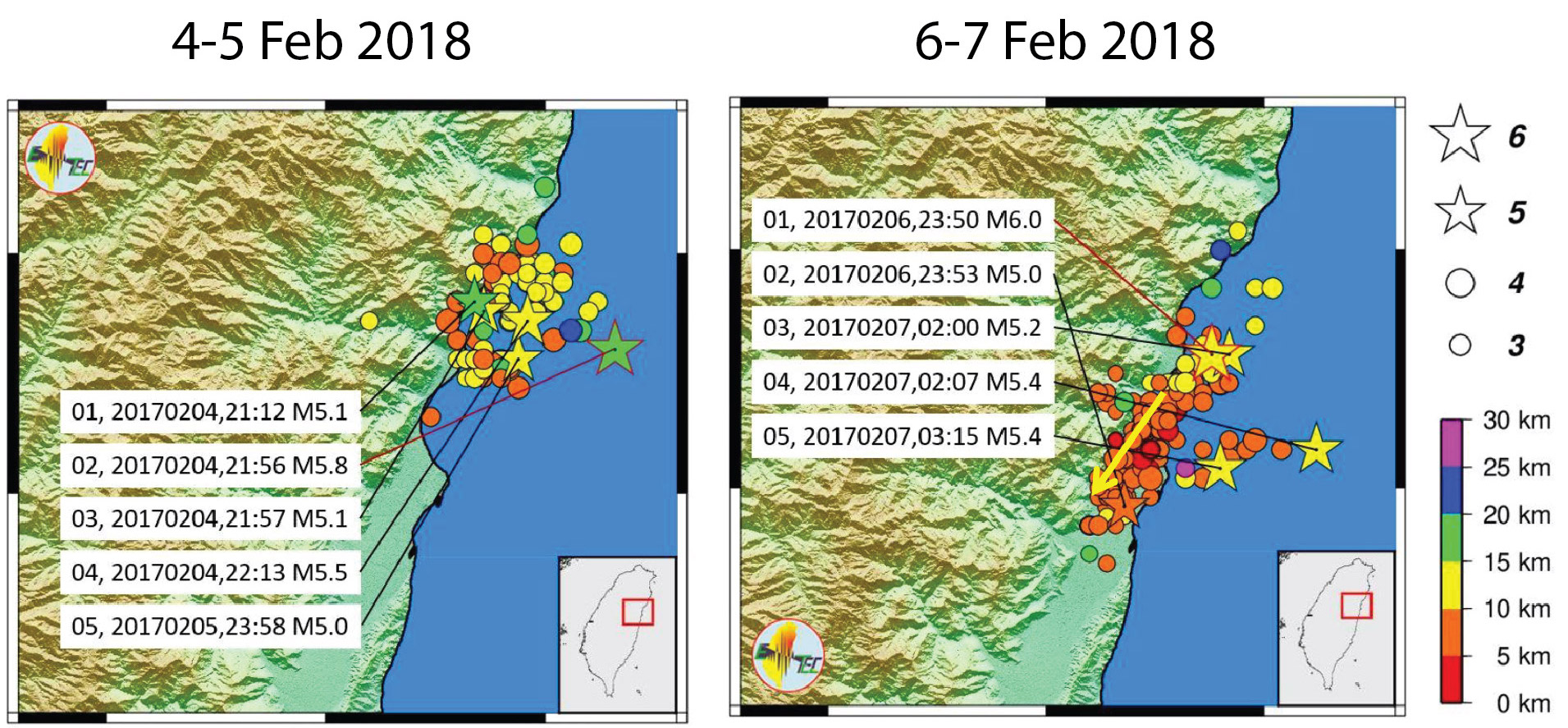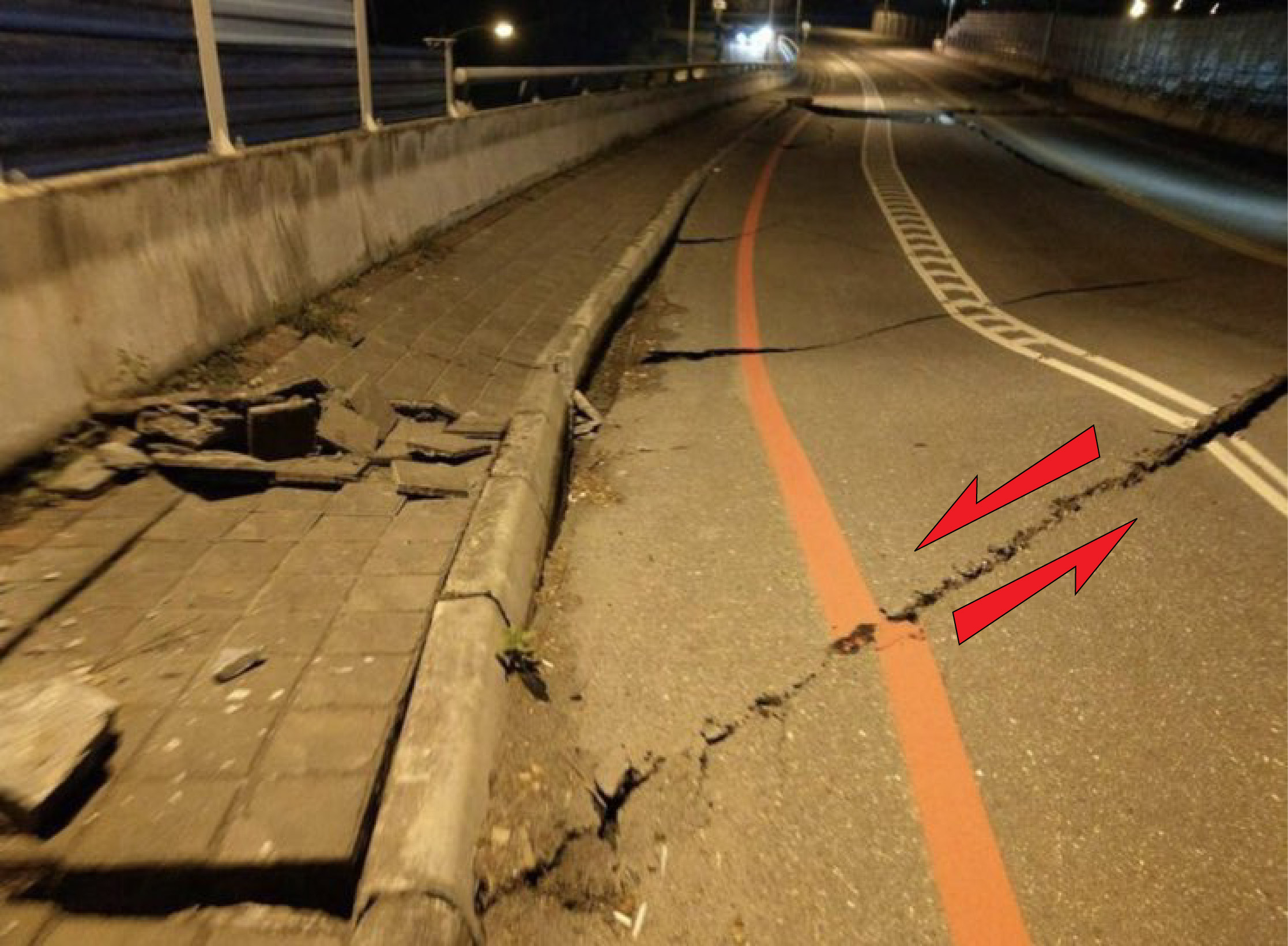By David Jacobson, Temblor
Updated: 1 p.m. Thursday Feb. 8, 2018

In Tuesday’s M=6.4 earthquake on Taiwan’s eastern coast, at least six people died and numerous buildings collapsed in the city of Hualien. Now that it has been a little over 48 hours since the quake, we know more about it, and where damage is concentrated, allowing us to develop hypotheses about what may have happened.

An astonishing foreshock sequence
In a typical aftershock sequence, the rate of earthquakes steadily declines. However, in the figure below, a time series shows that approximately 12 hours prior to the M=6.4 on Tuesday, the rate of earthquakes began increasing. While the exact reason for this increase is unclear, it should be noted that there is no increase in GPS velocities associated with the building in quake rates.

An additional factor regarding the aftershock sequences is the distribution of earthquakes. The figure below highlights the location of aftershocks following both Saturday’s M=6.1 and Tuesday’s M=6.4. While the aftershocks after the M=6.1 are more of a smear, there is a clear directionality to the southwest in the quakes following the M=6.4. This leads us to believe they occurred on different faults, which lends itself to hypotheses over which fault may have been the cause of Tuesday’s deadly quake.

Crime scene
Based on the location of Tuesday’s M=6.4 earthquake there are numerous candidate faults. On Tuesday we pointed out that the recent quakes struck at the intersection of the Ryukyu Trench and the northern extension of the Longitudinal Valley Fault, a 150 km-long fault that snakes its way across eastern Taiwan. Because this is a junction of two major systems, there are likely many unmapped faults, many of which could be capable of generating a M=6.4 earthquake like the one on Tuesday. Additionally, the ‘yin-yang’ of seismology means that there are two (mutually perpendicular) fault planes possible for every earthquake focal mechanism, making it still harder to read the tea leaves. In Tuesday’s event, the two possible solutions are left-lateral strike-slip and right –lateral strike-slip. So, here we focus on a major fault that many Taiwanese scientists believe could be responsible, weighing the arguments for and against its role in the quake.

Could the Meilun Fault be responsible?
One of the major active structures in Eastern Taiwan is the Meilun Fault, which runs right underneath the city of Hualien. Some scientists speculate that the Meilun Fault is just part of the major Longitudinal Valley structural system while others believe it is an independent feature. While it has been quiet during the past two decades, it ruptured in a M=7.3 earthquake in 1951 (Chen et al., 2008), and is capable of generating still-larger quakes because of the length of the Longitudinal Valley Fault.
In Tuesday’s earthquake, one of the many pictures which caught our attention was one of a damaged road (see below). In this picture there is evidence of left-lateral motion (whichever side of the fault you are on, the other side has moved to the left). Even though the Meilun Fault is often mapped as a reverse (compressional) fault, it does have a significant left-lateral strike-slip component. Such strike-slip motion matches the dominant movement shown in the focal mechanism produced by both the USGS and GFZ Potsdam for Tuesday’s M=6.4 event. Additionally, in the 1951 M=7.3 earthquake, the co-seismic vertical offset was ~1.2 m, while the left-lateral offset was ~2 m. Therefore, oblique ruptures, when there is both strike-slip and dip-slip motion, are possible along the Meilun Fault.

Further supporting the idea that the Meilun Fault was responsible for Tuesday’s earthquake is the distribution of collapsed buildings. In the figure below, five of the collapsed buildings (red dots) are shown in relation to the fault (red dashed line). All of these buildings are within a few hundred meters of the fault, where peak ground accelerations reached nearly 1.0 g, which the USGS considers extreme shaking, with the potential to cause very heavy damage.

Arguments against the Meilun Fault
While all of these points appear to support the idea that the Meilun Fault was responsible for Tuesday’s earthquake, there are counterarguments. First, as was pointed out, the Meilun Fault has a large compressional component, which was not evident in the focal mechanisms produced. Additionally, in both the Temblor and J. Bruce H. Shyu maps shown above, the Meilun Fault is not in the vicinity. In fact, in the Temblor map, Tuesday’s quake is on the wrong side of the fault, assuming the fault dips to the east. And, in the J. Bruce H. Shyu, the fault is shown to trend to the east. Therefore, not all facts point in the same direction.
Furthermore, while five of the collapsed buildings are in very close proximity to the fault, their demise could be explained by two other factors, resonance and liquefaction. In the figure showing collapsed buildings, there is graph on the right-hand side that shows a pulse of energy at the 2.5 second mark that reached nearly 1.0 g. Such ground shaking could have toppled the buildings. Additionally, all the buildings are close to bodies of water, where there is an elevated liquefaction potential, according to the Central Geological Survey.

This earthquake sequence should not be considered surprising
What all of these facts show is that there remains uncertainty over what fault caused Tuesday’s M=6.4 earthquake. While ground investigation could lead to greater knowledge, we also may never know, as the epicenter was location offshore. Nonetheless, this earthquake should not be considered surprising as the entire regions is extremely susceptible to large magnitude earthquakes. Therefore, the immediate concern is recovering those trapped, and understanding how to better prepare the region.

References
Central Weather Bureau
USGS
EMSC
New York Times
CNN
Kate Huihsuan Chen, Shinji Toda, and Ruey-Juin Rau, A leaping, triggered sequence along a segmented fault: The 1951 ML 7.3 Hualien-Taitung earthquake sequence in eastern Taiwan, JOURNAL OF GEOPHYSICAL RESEARCH, VOL. 113, B02304, doi:10.1029/2007JB005048, 2008
Shyu, J.B.H., et al., Seismotectonic characteristics of the northernmost Longitudinal Valley, eastern Taiwan: Structural development of a vanishing suture, Tectonophysics (2016), http://dx.doi.org/10.1016/j.tecto.2015.12.026
Taiwan Earthquake Research Center Report – Link
- Beware quiet segments of the Philippine Fault - May 16, 2025
-
ډیری عوامل افغاني ټولنې د زلزلې پر وړاندې زیانمنوي
- August 11, 2022 - What’s happening this week in Humboldt County, California: The squeeze - February 6, 2019
